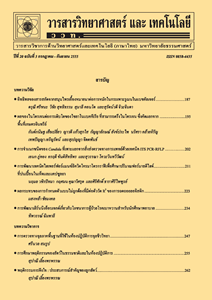การศึกษาความหลากหลายทางพันธุกรรมของไผ่ในประเทศไทยโดยใช้เครื่องหมายโมเลกุลชนิด EST-SSR จากอ้อย
Main Article Content
Abstract
บทคัดย่อ
ไผ่เป็นพืชที่มีการกระจายตัวในหลายภูมิภาคของโลก ในภูมิอากาศร้อนชื้นอย่างประเทศไทย สามารถพบไผ่ได้หลายสกุลในประเทศ การศึกษาเกี่ยวกับโครงสร้างทางพันธุกรรมและความหลากหลายทางพันธุกรรมของไผ่เป็นส่วนสำคัญในจำแนกและวางแผนการอนุรักษ์พันธุ์ไผ่ เครื่องหมายโมเลกุลชนิด EST-SSR พัฒนามาจากลำดับเบสที่อนุรักษ์ของยีน สามารถถ่ายโอนข้ามชนิดของพืชที่มีวิวัฒนาการใกล้เคียงกันได้ ในการศึกษานี้ใช้เครื่องหมายโมเลกุลชนิด EST-SSR จากอ้อยมาใช้ในการศึกษาโครงสร้างทางพันธุกรรมและความหลากหลายทางพันธุกรรมของไผ่ที่เก็บมาจากพื้นที่ต่างๆ ในประเทศไทย ผลการทดลองพบว่าเครื่องหมาย EST-SSR ของอ้อยจำนวน 53 เครื่องหมาย สามารถใช้ได้ในไผ่ 11 สกุล 32 สปีชีส์ จำนวน 11 เครื่องหมาย มี 8 เครื่องหมายที่สามารถสร้างแถบดีเอ็นเอแบบ polymorphic ได้ทั้งหมด 232 แถบ มีค่า Polymorphism Information Content เฉลี่ยเท่ากับ 0.72 แสดงให้เห็นว่าเครื่องหมายโมเลกุลชนิด EST-SSR ของอ้อยสามารถใช้ในการวิเคราะห์ความหลากหลายทางพันธุกรรมของไผ่ได้ดี ผลการวิเคราะห์การจัดกลุ่มของตัวอย่างไผ่นั้นพบว่าโดยส่วนใหญ่ไผ่สามารถจัดกลุ่มอยู่ในสกุลเดียวกันและพื้นที่เก็บตัวอย่างใกล้เคียงกัน จากการวิเคราะห์ความแปรปรวนของพันธุกรรมไผ่พบว่าความแปรปรวนของพันธุกรรมไผ่ได้รับอิทธิพลจากความหลากหลายของสปีชีส์ไผ่ที่อยู่ภายในสกุลเดียวกันมากกว่าอิทธิพลจากความแตกต่างของสกุล
คำสำคัญ : ไผ่; ความหลากหลายทางพันธุกรรม; อ้อย; EST-SSR
Abstract
Bamboos are widely distributed in the diverse climates around the world, and there are many genera of bamboos in Thailand. Understanding genetic structure and diversity of bamboos is important for identifying and planning for conserving programs. Express sequence tags derived simple sequence repeat (EST-SSR) markers developed from conserved coding sequences show considerable cross–species transferability in related species. In the present study sugarcane EST-SSR markers were selected and used for evaluation of genetic structure and genetic diversity of bamboos collected from different regions within Thailand. Of 53 Sugarcane EST-SSR markers, 11 markers could be transferred into 32 species from 11 genuses of bamboos. A total of 232 alleles were detected from eight polymorphic EST–SSR markers. Transferred EST–SSR markers revealed a high average polymorphism information content of 0.72 indicating that the markers was efficiently utilized for phylogenetic and genetic diversity analyses in bamboo. Cluster analysis reflected geographic distance and related species within genus. An analysis of molecular variance indicated that the genetic variation among species within genus contributed mainly to the total genetic variation of bamboo distributed in Thailand.
Keywords: genetic diversity; bamboo; EST-SSR; sugarcane


